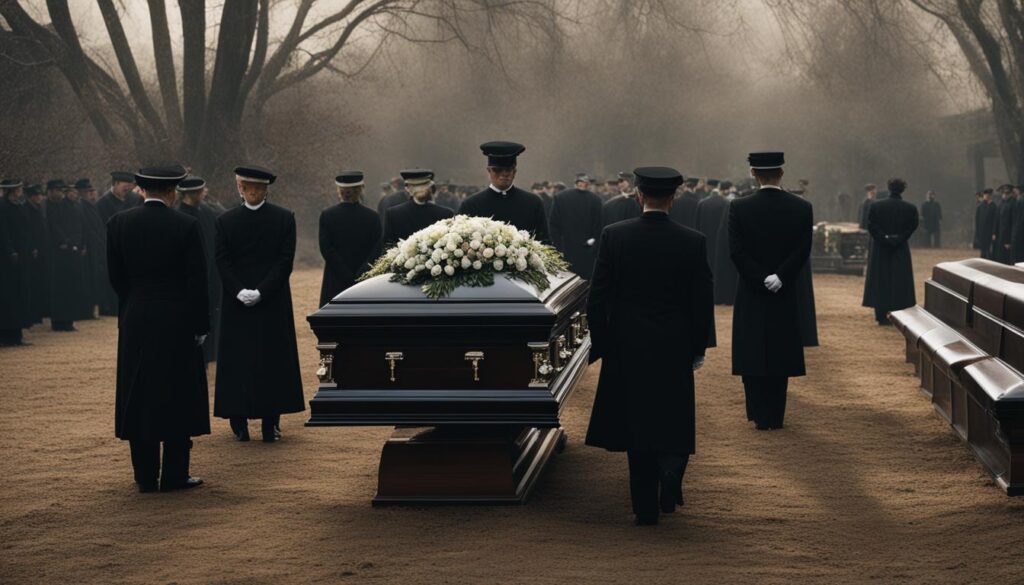We may earn money or products from the companies mentioned in this post.
Funeral rituals are an important part of many cultures. They provide an opportunity to mourn the loss of loved ones and celebrate their lives. However, it’s essential to be aware of proper funeral etiquette and customs to avoid causing unintentional offense or disrespect. This guide will provide you with a comprehensive understanding of funeral traditions, burial customs, and funeral ceremonies.
Key Takeaways:
- Funeral etiquette and customs vary across cultures and religions
- Knowing proper funeral etiquette can help you show respect and support to grieving families
- Appropriate attire, behavior, and expressions of condolences are crucial during funeral ceremonies
- Family members have specific roles and responsibilities during funerals
- Funeral services can include unique customs and traditions, such as specific rituals and prayers
Funeral Etiquette Guidelines for Attendees
When attending a funeral, it’s important to follow proper funeral etiquette guidelines to show respect for the deceased and their loved ones. Here are some guidelines to keep in mind:
Dress Appropriately
It’s important to dress in appropriate clothing that shows respect for the deceased and their family. This usually means wearing dark or muted colors, such as black, navy blue, or gray. Avoid wearing bright colors or flashy clothes, as they can be seen as disrespectful.
Arrive on Time
Arriving on time to the funeral is important to show respect for the deceased and their loved ones. If you’re running late, it’s best to wait until after the service to enter.
Behavior During the Funeral Service
Be sure to keep your cell phone off or on silent during the funeral service. You should also remain quiet and respectful during the service, refraining from any side conversations or disruptions.
“When someone you know dies, it’s important to show up.” – Former First Lady Michelle Obama
Offer Condolences
Offering condolences to the family of the deceased is an important part of the funeral service. It’s appropriate to offer a hug or handshake, express sympathy, and offer any assistance you can provide. It’s important to use an appropriate tone and avoid saying anything that could be seen as insensitive or inappropriate.
Funeral Viewing Etiquette
When attending a funeral viewing, it’s important to show proper etiquette as well. Be sure to sign the guestbook, offer condolences, and respect the wishes of the family. If there is an open casket, it’s appropriate to approach and pay your respects, but be sure to keep your behavior and emotions in check.
Mourning Etiquette
Following the funeral service, you may be invited to attend a reception or wake. It’s appropriate to offer condolences again, and to provide assistance in any way you can. It’s also important to respect the feelings of the grieving, and to avoid saying or doing anything that may be perceived as insensitive.
Customs and Traditions in Funeral Services
Funeral customs and traditions vary greatly between cultures and religions. These customs and practices help honor and remember the deceased while providing comfort to the loved ones left behind.
African American Funeral Traditions
African American funerals are often very emotional and involve lively music and passionate preaching. The funeral service typically takes place in a church, with the casket open for viewing. Mourners may be encouraged to wear white, symbolizing the hope of new life beyond death.
Asian Funeral Customs
Asian cultures have their unique funeral customs, including long periods of mourning and honoring the dead through ancestral worship. In many Asian traditions, the casket is open during the funeral service as a way for mourners to say goodbye. A wake is typically held the night before the funeral, where family members and friends may gather to pay their respects.
Jewish Funeral Traditions
Jewish funerals are typically somber affairs, with mourners tearing their clothing to symbolize the tearing of one’s heart at the loss of a loved one. The funeral usually takes place within a day or two of death, with the casket closed and buried as soon as possible. There is a seven-day period of mourning called Shiva, during which the immediate family sits on low stools or on the floor and receives visitors who offer condolences.
Native American Funeral Customs
Native American funeral customs are often steeped in tradition and spirituality. The deceased is honored for their contributions to the community, and the funeral ceremony may involve a purification ritual to ensure the safe passing of the soul into the afterlife. The body may be laid to rest in a wooden casket or wrapped in a traditional blanket and buried facing east, symbolizing the direction of the rising sun.
Catholic Funeral Traditions
The Catholic funeral is a solemn and dignified ceremony that emphasizes prayers for the soul of the departed. The casket is typically open during the wake and funeral mass held at a church. The funeral includes a eulogy, scripture readings, and communion. Mourners are encouraged to dress conservatively and wear black.
Buddhist Funeral Customs
Buddhist funerals are often simple and quiet affairs, emphasizing the transience of life and the impermanence of all things. The body is typically cremated, and mourners may be expected to bring flowers or incense and participate in chanting. Monks may preside over the ceremony, offering teachings on the Buddhist concept of rebirth and the cycle of life.
“Funeral customs and traditions provide a way for loved ones to honor and remember the deceased, while also offering comfort and support during a difficult time.”
Funeral Etiquette for Family Members
When it comes to funeral etiquette, immediate family members have a unique role and responsibilities during the funeral service. Here are some guidelines to help you navigate this difficult time with proper etiquette:
Roles and Responsibilities
As an immediate family member, you may have specific roles and responsibilities during the funeral service, such as being a pallbearer, delivering a eulogy, or leading a prayer. It’s important to communicate with the funeral director and other family members to understand these responsibilities and plan accordingly.
Appropriate Behavior
During the funeral service, it’s essential to show respect and dignity. Be sure to arrive on time, turn off your mobile phone, and avoid any disruptive behavior or conversation. You should also avoid taking pictures or recording the service unless it’s been approved by the family.
Dress Code
It’s essential to dress appropriately for the funeral service. Traditional funeral attire includes somber colors such as black, navy blue, or gray. Men may consider wearing a suit and tie, while women may wear a dress or suit. Avoid wearing anything too revealing or distracting.
Expressing Condolences
Expressing condolences can be challenging, but it’s important to show support and sympathy to the family. Offer your condolences in person, with a card, or a phone call. Simple phrases such as “I’m sorry for your loss” or “My thoughts are with you and your family” can bring comfort and support to those in grief.
Mourning Etiquette
Mourning is a personal and emotional process that can vary from person to person. As a family member, it’s essential to respect each other’s grieving process and provide support and comfort as needed. Avoid judging or criticizing others’ behaviors or emotions and allow them to grieve in their way.
By following these funeral etiquette guidelines, family members can create a respectful and dignified funeral service for their loved one and help each other find comfort and support during this difficult time.
Etiquette for Funeral Guests and Friends
When it comes to attending a funeral as a guest or friend, following proper funeral etiquette is crucial. This is a time to show your support and respect for the deceased and their grieving family while paying your last respects. Here are some guidelines to follow:
Dressing Appropriately
It’s important to dress appropriately for a funeral. Men should wear a suit or dress pants with a dress shirt and tie, while women should wear a dress or a skirt with a blouse. Avoid wearing anything too flashy or revealing, such as shorts or a hoodie. Remember that this is a solemn event, and dressing respectfully is a sign of respect for the deceased and their family.
Offering Condolences
If you see the immediate family of the deceased, offer your condolences. A simple “I’m sorry for your loss” can go a long way. If you’re not sure what to say, keep it brief and express your sympathy. It’s important to avoid saying anything that could be interpreted as insensitive or dismissive.
Respecting Wishes
It’s important to respect the wishes of the grieving family during a funeral. This can include adhering to specific traditions or customs, such as refraining from taking photos or videos during the service. If the family requests that donations be made to a specific charity in lieu of flowers, consider making a donation in honor of the deceased.
Seating Arrangements
When entering the service, follow the ushers’ instructions on where to sit. If you’re not sure where to sit, look for reserved seats for family members and avoid sitting in these areas. If you’re accompanying a friend or family member to the funeral, sit with them for support.
During the Service
During the service, it’s essential to be respectful and attentive. Avoid making unnecessary noise or distracting others during the ceremony. Turn off your phone or switch it to silent mode. You can participate in prayers or hymns if you feel comfortable doing so, but it’s okay to remain seated if you prefer not to participate.
After the Service
After the service, take the time to say goodbye and offer your condolences to the family. If the family has arranged for a reception or gathering, consider attending to pay your respects and offer support. Remember that this is a difficult time for the family, and even a small gesture of kindness can make a significant impact.
Funeral Etiquette and Customs: Modern Perspectives
As society continues to evolve, so too do funeral etiquette and customs. It’s important to recognize that traditional funeral practices may not resonate with everyone, and modern approaches to memorializing loved ones are becoming increasingly popular.
Alternative Funeral Options
Traditional funerals can be expensive and time-consuming, leading many people to seek out alternative options. Green burials, for example, are becoming more common as people look for eco-friendly ways to say goodbye to their loved ones. These burials typically involve burying the deceased without embalming or using a casket made of biodegradable materials such as bamboo or wicker.
Another alternative funeral option is cremation. This method is growing in popularity due to its cost-effectiveness and the flexibility it offers families in terms of how they choose to memorialize their loved one. Cremated remains can be scattered, kept in an urn, or even turned into jewelry or art.
Memorial Services
Memorial services, which are typically held after a cremation or burial, offer a more personalized way to say goodbye to a loved one. These services can take place anywhere, from a park to a family home, and can be tailored to reflect the interests and personality of the deceased.
Celebrations of Life
Celebrations of life are becoming an increasingly popular way to honor the memory of loved ones. These events focus on celebrating the life and accomplishments of the deceased rather than mourning their loss. They can take many forms, from elaborate parties to intimate gatherings, and are a great way to bring together friends and family to share stories and memories.
Funeral Etiquette in Different Cultures
Funeral customs and traditions vary greatly across different cultures and religions. Understanding and respecting these customs is essential when attending a funeral or offering condolences to a grieving family. Here are some examples of funeral customs in various cultures:
African American Funerals
Funerals in African American culture are often a celebration of life, with lively music, dancing, and tributes to the deceased. The traditional “homegoing” service includes a series of events, including a wake, funeral service, and repast. Dress is typically formal and respectful, with black or dark clothing being the most common attire.
Asian Funerals
Asian funeral customs vary by country and religion. In Chinese culture, funeral rites may include ancestral worship, including offerings of food and incense. The family may also wear white clothing, which symbolizes mourning. In Hinduism, cremation is the norm, and the family may scatter the ashes in a sacred body of water.
Jewish Funerals
Jewish funeral customs are steeped in tradition and follow specific rituals. The body is typically buried within 24 hours of death, and mirrors are often covered in the house of mourning to prevent vanity. Mourners may tear their clothing, and it is customary to bring food to the family during shiva, the seven-day mourning period.
Muslim Funerals
Muslim funeral customs are based on Islamic beliefs and teachings. The body is washed and shrouded in white cloth, and burial must take place as soon as possible after death. Friends and family may gather to recite prayers and offer condolences, and it is customary to bring food to the family during the mourning period.
Native American Funerals
Native American funeral traditions vary by tribe and region. In many traditions, the body is laid out facing east, and the family may burn sage or other herbs to purify the space. The family and community may also participate in a traditional dance or ceremony to honor the deceased.
These are just a few examples of the diverse funeral customs and traditions across different cultures. By understanding and respecting these customs, we can offer our condolences and support in a respectful and appropriate manner.
Conclusion
In conclusion, understanding funeral etiquette and customs is crucial to ensure that we behave appropriately and respectfully during these solemn events. By following the guidelines provided in this guide, we can show our support for grieving families while honoring the memory of the deceased.
A Final Word on Funerals
Funerals are an important part of the grieving process. They provide an opportunity for friends and family to come together to mourn the loss of a loved one, and to celebrate their life.
While funeral etiquette and customs may vary across different cultures and religions, the underlying principles of respect and empathy remain constant. By showing compassion for the bereaved and honoring the deceased, we can create a meaningful and healing experience for all those involved.
Thank you for taking the time to read this guide on funeral etiquette and customs. We hope that it has been helpful in providing you with the knowledge and guidance necessary to navigate these difficult times.
Our thoughts are with all those who have lost someone special.
FAQ
What is funeral etiquette?
Funeral etiquette refers to the customary behavior and practices that are expected during funerals and related ceremonies. It helps ensure that mourners and attendees show respect and support for the grieving family.
Should I attend the funeral if I didn’t know the deceased?
It is generally considered appropriate to attend a funeral even if you didn’t know the deceased. Funerals provide an opportunity to offer support and express condolences to the grieving family.
What should I wear to a funeral?
It is customary to dress in formal or conservative attire when attending a funeral. Men typically wear a suit or dress pants with a dress shirt and tie, while women often wear a dress, skirt, or pantsuit in subdued colors.
How should I express my condolences?
Offering condolences can be done through various means, such as sending a sympathy card or letter, attending the funeral service, or offering support to the grieving family. It is important to express genuine sympathy and provide comfort.
Should I bring a gift to a funeral?
While it is not mandatory, bringing a small gift or flowers to a funeral can be a thoughtful gesture. It shows your support and can provide comfort to the grieving family. Consider the religious and cultural customs before bringing any specific gifts.
How long should I stay at a visitation or viewing?
There is no set duration for how long you should stay at a visitation or viewing. It is customary to spend some time with the grieving family, offer condolences, and pay respects to the deceased. Use your judgment and be mindful of the family’s needs.
Can I take photographs or use my phone during a funeral service?
It is generally considered inappropriate to take photographs or use your phone during a funeral service. Funerals are solemn occasions, and it is important to show respect and avoid distractions.
Can children attend a funeral?
Children can attend a funeral, but it is important to consider their age and readiness to understand the event. It may be helpful to prepare them in advance and provide support during the funeral. If the child becomes too overwhelmed, it is acceptable to remove them from the service.
Can I offer to help with funeral arrangements?
Offering to help with funeral arrangements can be a kind gesture, especially if you are close to the grieving family. However, it is important to respect their wishes and be mindful of their preferences during this difficult time.
Should I send a sympathy card or attend a memorial service if I can’t attend the funeral?
If you are unable to attend the funeral, sending a sympathy card or letter can be a thoughtful way to express your condolences. Additionally, if there is a memorial service, you may consider attending to show support for the grieving family.
Affiliate Disclosure: This post may contain affiliate links. If you purchase through our link, we may receive a small commission, but at no additional cost to you. For more information, please see our Disclosure statement.



